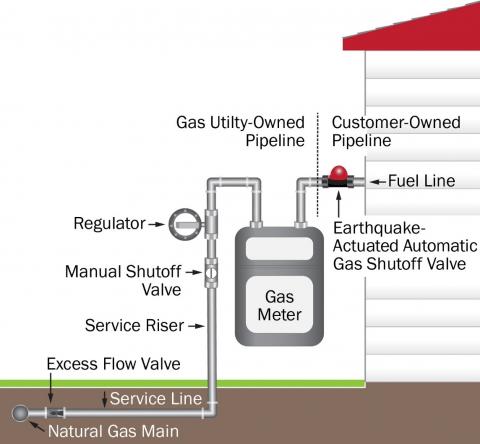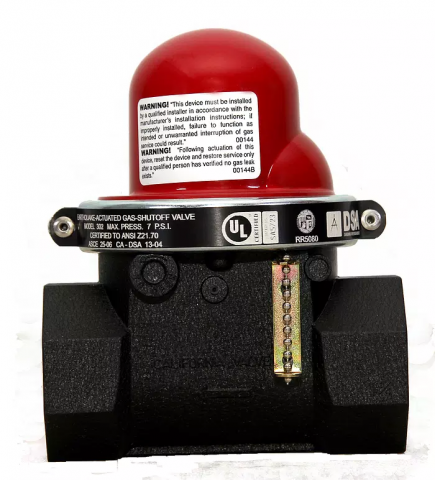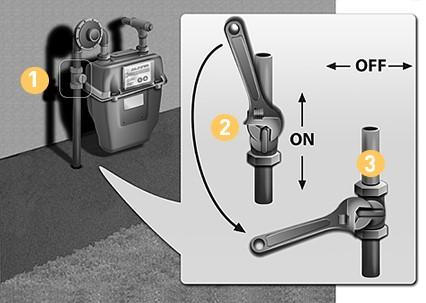Scope
In homes that are equipped with a gas line that runs from the utility line to the home, install an automatic gas shutoff valve that shuts off the flow of natural gas to a home in the event of an earthquake or line rupture, if required by local building code or requested by the homeowner if required by the homeowner’s insurance company or desired by the homeowner for peace of mind. There are two types of automatic gas shutoff valves: seismic (or earthquake-actuated) valves and excess flow valves. Seismic gas shutoff valves (also called earthquake valves) shut off the flow of gas from the meter to the house if earth movement equivalent to about 5.4 or more on the Richter scale is detected. Excess flow valves stop the flow of gas from the street to the meter if excess flow or loss of pressure is detected, indicating a potential rupture of the gas line due to any cause (construction, earthquake, other natural disaster, tree roots, etc.).
- Determine whether the homeowner desires or is required by local ordinance to install a seismic valve and/or an excess flow valve.
- Select a model that is approved in your jurisdiction and install in accordance with local ordinances.
- Seismic valves are installed on the homeowner’s side of the meter by a licensed plumber or the homeowner.
- Excess flow valves are installed on the utility side of the meter by the utility.
See the Compliance Tab for links to related codes and standards and voluntary federal energy-efficiency program requirements.
Description
Homes that are equipped with a gas line that runs from the utility line to the home should have an automatic gas shut-off valve (ASV) (Figure 1), which is a valve that shuts off the flow of gas into a home due to an earthquake or other event that causes a rupture of the gas line, thus reducing the chance of explosion or fires from leaking gas. Shaking or movement of a building or the appliances in the home in the event of an earthquake or other natural disaster can cause damage to the gas piping and appliances, causing the accidental release of natural gas, which can lead to fires or explosions. Structural weaknesses, the absence of appliance anchors, and lack of flexible pipe connectors can all contribute to a greater possibility of gas leaks (Danville 2021).

Types of Automatic Gas Shutoff Valves
All homes that have natural gas have a manual shutoff valve located on the gas meter that can be closed using a wrench to stop the flow of natural gas into the home in the event of an emergency (Figure 5). However, the home’s occupants may not be available to close the line in the event of a natural disaster or may not be aware of a rupture of the line due to some other cause such as digging. If an automatic gas shutoff valve is installed on the line, it can stop the flow of gas quickly in the event of an emergency with no human intervention needed, preventing large gas spills from occurring and potentially causing fires or explosions.
There are two types of automatic gas shut-off devices: earthquake-actuated gas shut-off valves (also known as seismic valves) and excess flow valves. The differences between the two valves are summarized in Table 1 and described below. Requirements for shutoff valves for natural gas lines vary by jurisdiction. The requirement typically applies to new building construction and significant alterations or additions to existing buildings (PG&E 2021). Because an earthquake valve is triggered by movement, not an actual line break, while it will prevent gas leakage from the initial quake or aftershocks, it will shut off the gas even if no rupture occurs to the gas line. In contrast, an excess flow valve is triggered by sudden high flow on the line, indicating a leak has occurred; earthquake movement alone won't trigger it. Utilities note that restoration of utility gas service after an emergency will take time, whether the gas valve has been shut manually or automatically, because the utility may require that its crews inspect the gas meter and equipment to verify there are no leaks in the line, clear active lines of residual gas, restore service to the lines, and relight pilot lights (PG&E 2021).
| Earthquake Shutoff Valve | Excess Flow Valve | |
|---|---|---|
| How does it work? | Senses earthquakes and large ground movement ≥ 5.4 on Richter Scale. | Senses gas leaks. |
| What does it do? | Stops flow of gas on fuel line from meter into home at first sign of earth movement. | Stops flow of gas on the service line between the main line and the meter when it detects high gas flow and/or loss of line pressure depending on valve model. |
| What doesn’t it do? | Won’t stop gas flow for reasons other than earthquakes, such as a line rupture due to digging or a faulty appliance. | Won’t stop gas flow during an earthquake unless the gas line is severed. Won’t stop flow of gas within your home due to puncture, small leak, or an appliance malfunction Won’t completely stop the flow of gas; may allow a small amount through. |
| What triggers it? | Triggered by ground shaking, equivalent to about 5.4 or greater on the Richter Scale. | Sensors on the gas line detect a large increase in gas flow rate due to a rupture of the service line (for any cause, such as earthquakes, tree roots, excavation equipment, severed line in house) |
| Where is it located? | On the homeowner’s side of the meter, usually outside and above ground on the fuel line between the meter and the home. | On the utility side of the meter, underground, on the service line between the main line and the gas meter |
| Who installs? | Licensed plumber or homeowner | Utility or utility contractor. |
| Who pays for it? | Homeowner | Homeowner (sometimes utility pays in new construction) |
| Who is responsible for maintenance and replacement? | Homeowner | Utility |
| Cost | $100-$1000 | $200-$7,000 |
| Is it required? | Varies. Check local building code. | Required by Federal law on all new homes with gas since 2006 (or earlier in some jurisdictions). Check local requirements for existing homes. |
| Who resets? | Requires manual reset to restart flow of gas. Can be reset by homeowner, or utility may require reset by utility staff. | Automatically resets after utility staff repairs the line. |
Earthquake-Actuated Gas Shutoff Valves
An earthquake-actuated gas shutoff valve (also known as an earthquake valve or a seismic valve) is a simple mechanical device installed just downstream of the meter on the pipe between the meter and the house (Figures 1 and 2). If the valve is subjected to significant movement, a ball or “float” in the valve drops into place to block the flow of gas through the pipe and into the building. If an earthquake does impact the home, gas flow will be stopped by the valve so gas will not continue to flow into the home, where it could potentially leak from any ruptures in the line downstream of the meter and possibly catch fire or explode. Earth movement equivalent to an earthquake registering approximately 5.4 or greater on the Richter scale will activate the locking mechanism. (The Richter scale ranges from 1.5-barely detectable to 9.5-catastrophic; a 5.4 quake could cause considerable damage.) Many utilities require the installer to attach a stabilizing bracket to the piping near the valve to minimize the likelihood that an accidental bump will activate the valve.
Seismic valves can be required by insurance companies or local departments of building and safety in areas prone to seismic activity. Some city, state, and/or county regulations require the installation of seismic valves; some leave this up to the owner’s discretion. Seismic valves are typically located on the homeowner’s side of the meter, on the pipeline leading from the meter into the house, which is usually located in an easily accessed location outside, above ground on the side or front of the house. The seismic valve is located downstream of the utility manual gas shut-off valve, pressure regulator, meter, and the service tee (see Figures 1 and 2).
Seismic valves are purchased by the homeowner and installed by either the homeowner or a licensed plumber or contractor who has been certified to do so. Most utilities do not install seismic valves (for example, SoCalGas 2021). Some utilities offer assistance in purchasing the valves. For example, the City of Malibu, California, requires a plumbing permit to install valves but waives fees for the permit process (City of Malibu). Utilities do not typically allow attachments or connections of any kind on the utility’s piping and equipment before the point where the service tee connects to the gas houseline piping. After installation, the valve must not obstruct any gas operations or utility services in or around their piping, gas service shut-off valves, gas meters, or gas pressure regulating equipment (PG&E 2021).
Seismic valve products should meet the requirements of ASCE 25-97 and ANSI Z21.70-1981 Standards for Seismic Gas Valves. Some locales require that installers use a state-approved model for excess flow gas shut-off valves and earthquake-actuated gas shut-off valves. Seismic valves installed in California should be certified by the California State Architect's Office as meeting California Standard No. 12-23-1 for Earthquake-Actuated Automatic Gas Shutoff Systems. The State of California’s Division of the State Architect (DSA) oversees the certification of both types of gas shutoff valves as required by the Health and Safety Code and lists approved models on the website of the DSA Gas Shut-off Valves Certification Program. Products used in Los Angeles need to be approved by the City of Los Angeles. Examples of seismic valves approved for use in California are shown in Figures 3 and 4.
Seismic valves will operate to shut off the gas when they sense enough earth movement, whether a line rupture occurs or not. If the gas is shut off by a seismic valve, some utilities specify that the homeowner is not to turn the gas back on themselves but should notify the utility to have a utility representative perform a safety check, restore gas service, and relight appliance pilot lights. For this reason, some utilities do not encourage the installation of seismic shutoff valves for residential service due to the time required to go around and reset all of the valves following an earthquake. Some jurisdictions require excess flow valves instead. Check the applicable jurisdiction for specific requirements in your area (FEMA E-74, 2011).
The valve is manually reset once a safety inspection has been done to verify there are no leaks in the building. Some jurisdictions allow homeowners to reset their own automatic shutoff valves. This is one reason some homeowners prefer to have an earthquake-actuated shutoff valve even if not required to do so by the local building department or their homeowner’s insurance company. In the event of an earthquake, an earthquake-actuated valve will shut off gas flow as soon as significant earth movement is detected without waiting to sense a gas leak. If, after the quake, no leaks are detected, the homeowner may be able to reset the valve or hire a plumber to reset the valve and re-establish gas service. Many homes have both types of valves.

Excess Flow Valves
Excess flow valves automatically stop the flow of gas on the service line between the main gas line at the street and the customer's meter (on the "utility side" of the meter) if excess flow or loss of pressure is detected, indicating a rupture of the gas line (American Gas Association 2011), whether the rupture is caused by an earthquake, or some other natural cause such as a sinkhole or a washout, or damage from digging or drilling equipment, or motor vehicle impact to the meter, or line breakage in the home.
In 2006, Congress mandated the use of excess flow valves on all new or replaced gas distribution lines serving single-family residences (49 CFR 192.383(a)). By the end of 2014, an estimated 9 million excess flow valves were in service and over 800,000 new valves were being installed every year (P&GJ 2016). In a Final Rule published in the Federal Register on October 14, 2016, the Pipeline and Hazardous Materials Safety Administration (PHMSA) made changes to 49 CFR Part 192 to expand the requirement to include multifamily residences and small commercial buildings, and required gas utilities to notify customers who had existing homes without excess flow valves of their right to request installation of one. For new homes, the cost of installation is included in the charge for the new line.
Dates at which utilities began installing excess flow valves for new homes vary by utility, although many pre-date the 2006 Congressional mandate. For example, all homes with gas service built in Oregon after 1993 have an excess flow valve installed by the utility at construction. With an existing home, if you are unsure if an excess flow valve is already installed, contact the gas utility. In existing homes without an excess flow valve, the customer can request that the utility install one, at the homeowner’s expense (Colorado Springs Utilities). The utility or their service contractor will install the excess flow valve on the underground service line pipe running from the street to the meter. Costs vary depending on location and difficulty of the installation, with reported costs ranging from $400 to $7,000. For example, the City of Ellensburg, Washington, estimates $500 to $1000 (City of Ellensburg). TECO Peoples Gas in Florida estimates $1,200 to $1,800 (TECO Peoples Gas). PG&E estimates $2,500 to $6,000 or more, based on the specific site (PG&E 2017).
Some things to note about excess flow valves (EFVs) (KUB 2021):
- EFVs activate only if the gas service line is severed.
- EFVs do not activate if the gas service line has only a small puncture or a small leak.
- EFVs do not protect against household appliance malfunctions.
- EFVs do not prevent leaks.
- EFVs do not operate on all gas service lines (for example very low-pressure or high-volume lines).
How to Manually Turn Off the Gas at the Main Shutoff Valve
In an emergency, some utilities tell their homeowners that the gas can be turned off at the main gas service shutoff valve, with the following guidelines (for example, PG&E 2021, SoCalGas 2021).
- Do not shut off the gas unless you smell gas, hear gas escaping, see a broken gas line, suspect a gas leak, or are advised to do so by the gas utility. If you shut off the gas, there may be a considerable delay before the utility can turn your service back on.
- Locate the main gas shutoff valve. It is typically next to the gas meter. It may be on the side of front of the house, or in a cabinet meter outside of the house, under the house, or underground.
- Have a wrench handy. Keep a 12- to 15-inch adjustable pipe or crescent-type wrench in a known location. It may not be advisable to keep it visible next to the meter where someone might use it to tamper with the meter.
- Give the valve a quarter turn in either direction. The valve is closed when the tang (the part of the valve you put the wrench on) is crosswise (perpendicular) to the pipe. See Figures 5 and 6.
Note, some jurisdictions and gas utility companies stipulate that manual gas shut-off can only be performed by the utility or its certified contractors (California Public Utilities Commission General Order 112-E).

How to Manually Turn Off the Gas to Each Natural Gas Appliance
In the event of a flood, earthquake, tornado, or wildfire, some utilities advise homeowners, if they can safely do so, to
- Turn off all gas appliances.
- Manually turn off the gas shutoff valve at each appliance. For safety, a shut-off valve should be installed at every natural gas appliance. If a leak happens at a specific appliance, the valve allows you to turn off the natural gas at the appliance rather than shutting off the natural gas service line to the whole house. Some valves require a wrench. See Figure 7.
- If you can’t shut off gas to an appliance, turn off the gas at the gas service shutoff valve, typically located near the gas meter.
- Consult your local utility for guidance. Some utilities advise homeowners not to shut off the gas unless they smell gas, hear gas escaping, see a broken gas line, or suspect a gas leak because, if they do shut off the gas, there may be a considerable delay before the utility can turn the service back on (for example, PG&E).
After a flood or other natural disaster, some utilities recommend the following to homeowners (for example, NW Natural Gas, PG&E, SoCalGas).
- Do not turn your gas back on if it has been turned off at the meter. Call for a gas utility technician to come out.
- Do not try to use a flooded meter or any gas equipment.
- Call the gas utility to reactivate the equipment and meter.
- Wait for an inspection by a qualified licensed HVAC technician or plumber before using any gas equipment that has been submerged.
- Let the gas company’s service technician check the equipment, open the gas line, and re-light pilot lights.
How to Turn off the Electricity
Some utilities recommend turning off electricity to the home before a predicted natural disaster event, or prior to evacuating, if safe to do so. Consult your local utility for guidance. Turn off the electric supply to the entire household at the main electric switch located on the electric panel. Never touch the electric switch or circuit breaker with wet hands or while standing in water (PG&E).
Success
Some city, county, and state regulations require the installation of automatic gas shut-off devices. There are two types of automatic gas shut-off devices: earthquake-actuated gas shut-off valves (also known as seismic valves) and excess flow valves. Earthquake/seismic valves should be installed by a licensed plumber. The State of California requires that seismic automatic gas shut-off valves be certified by the state and installed by a licensed plumbing contractor in accordance to the manufacturer’s instructions. Your municipality may require one or the other or both. The requirement typically applies to new building construction and significant alterations or additions to existing buildings. Check with your local city or county building department and your gas utility to see what is required and allowed in your location.
Climate
Advise homeowners to know the disasters likely to occur in the home’s location and to consult with their utilities or utility websites regarding what to do about gas and electric service during those disasters before a disaster strikes.
Show homeowners where the gas valves are on each gas or propane appliance installed and where the main gas valve is located (likely outside of the home upstream of the meter) and explain how to turn it off. Also, show the homeowner where the electric panel is and the main switch on the panel.
Earthquakes
Figure 1 shows the probability of an earthquake occurring in various locations in the United States. Because earthquakes can strike at any time without warning, in locations prone to earthquakes, some municipalities require seismic gas shutoff valves and/or excess flow valves. Seismic gas shutoff valves shut off the flow of gas from the meter to the house if earth movement equivalent to about 5.4 or more on the Richter scale is detected. Excess flow valves stop the flow of gas in the service line from the street to the meter if excess flow or loss of pressure is detected indicating a potential rupture of the gas line for whatever reason. Whether required or not, homeowners may wish to install either or both valves. Check with the local code authority and gas utility to see what is required or allowed and follow the guidance given in the Description tab of this guide.
Wildfires
Show homeowners how to access and close the individual valves on all gas and propane appliances (IBHS) and where to manually turn off the main valve if directed to do so by their utility.
Floods or Hurricanes
Some utilities recommend that homeowners manually shut off the gas at the meter if flood waters are likely to rise above the level of the gas meter or appliances (NW Natural Gas).
In the event of an expected flood, some utilities advise homeowners to:
- Turn off all gas appliances.
- Manually turn off the gas shutoff valve at each appliance.
- If you can’t shut off gas to an appliance, turn off the gas at the gas service shutoff valve typically located near the gas meter.
After a flood, some utilities recommend the following to homeowners (for example, NW Natural Gas, PG&E, SoCalGas):
- Do not turn your gas back on if it has been turned off at the meter. Call for a gas utility technician to come out.
- Do not try to use a flooded meter or any gas equipment.
- Call the gas utility to reactivate the equipment and meter.
- Wait for an inspection by a qualified licensed HVAC technician or plumber before using any gas equipment that has been submerged.
- Let the gas company’s service technician check the equipment, open the gas line, and relight pilot lights.
Training
Compliance
Compliance
Retrofit
In existing homes in earthquake-prone regions, if an earthquake-actuated automatic gas shutoff valve is desired by the homeowner or required by local code, follow the guidance in the Description tab for selecting and installing the valve on the fuel line on the house side of the meter.
Consult with the utility to see if an excess flow valve has already been installed on the underground service line going from the natural gas main line to the meter. If none has been installed and the homeowner desires or is required by local ordinance to have one installed, they can request one from the utility and the utility will install the excess flow valve at the homeowner’s expense.
More
More Info.
Access to some references may require purchase from the publisher. While we continually update our database, links may have changed since posting. Please contact our webmaster if you find broken links.
How To Shut Off Your Natural Gas In An Emergency – Learn How To Locate And Shut Off Your Natural Gas
The following authors and organizations contributed to the content in this Guide.
Pacific Northwest National Laboratory






